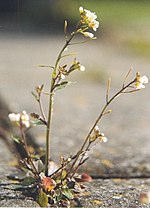Pseudomonas syringae is a rod-shaped, Gram-negative bacterium with polar flagella. As a plant pathogen, it can infect a wide range of species, and exists...
55 KB (5,788 words) - 03:48, 21 November 2024
populations. Various strains of Pseudomonas are recognized as pathogens in the plant kingdom. Notably, the Pseudomonas syringae family is linked to diseases...
95 KB (8,008 words) - 11:40, 7 October 2024
pathogens. Infections by the gram-negative fluorescent bacterium Pseudomonas syringae pathovar aesculi are a new phenomenon, and have caused most of the...
11 KB (1,167 words) - 03:06, 30 August 2023
Halo blight (redirect from Pseudomonas syringae pv. phaseolicola)
Halo blight of bean is a bacterial disease caused by Pseudomonas syringae pv. phaseolicola. Halo blight’s pathogen is a gram-negative, aerobic, polar-flagellated...
9 KB (1,304 words) - 12:04, 1 September 2023
infects a variety of plants. It was once considered a pathovar of Pseudomonas syringae, but following DNA-relatedness studies, it was instated as a new...
8 KB (573 words) - 12:56, 26 October 2024
Pseudomonas syringae, but following ribotypical analysis, it was reinstated as a species. The type strain is CFBP 2341.[citation needed] Pseudomonas cannabina...
12 KB (1,310 words) - 04:46, 30 December 2023
Bacterial blight of soybean (redirect from Pseudomonas syringae pv. glycinea)
blight of soybean is a widespread disease of soybeans caused by Pseudomonas syringae pv. glycinea. Soybeans are grown all over the world and are a primary...
13 KB (1,609 words) - 12:05, 1 September 2023
Vicia faba (section Pseudomonas syringae)
resistant cultivars, seed treatments, and copper bactericides. Pseudomonas syringae overwinters on residue. Uninfected seed, rotation, and removal of...
42 KB (5,448 words) - 21:36, 24 October 2024
Pseudomonas fluorescens is a common Gram-negative, rod-shaped bacterium. It belongs to the Pseudomonas genus; 16S rRNA analysis as well as phylogenomic...
30 KB (3,244 words) - 13:24, 20 August 2024
relatedness among the pathovars of Pseudomonas syringae and description of Pseudomonas tremae sp. nov. and Pseudomonas cannabina sp. nov. (ex Sutic and...
4 KB (310 words) - 20:42, 28 November 2022
P. syringae group together with the species Pseudomonas ficuserectae and Pseudomonas meliae, and 27 pathovars of Pseudomonas syringae/Pseudomonas savastanoi...
11 KB (1,004 words) - 19:56, 11 July 2023
given to a variant of the common bacterium Pseudomonas syringae (P. syringae). This strain of P. syringae lacks the ability to produce a certain surface...
11 KB (1,420 words) - 13:34, 31 August 2024
caused by the bacterium Pseudomonas savastanoi, rather than Pseudomonas syringae. After DNA-relatedness studies Pseudomonas savastanoi has been instated...
6 KB (611 words) - 10:58, 25 October 2024
susceptibility to bacteriosis, especially canker (also known as PSA (Pseudomonas syringae pv. actinidiae)). The first cultivar of gold kiwifruit, Hort16A,...
5 KB (477 words) - 19:06, 2 October 2024
relatedness among the pathovars of Pseudomonas syringae and description of Pseudomonas tremae sp. nov. and Pseudomonas cannabina sp. nov. (ex Sutic and...
3 KB (231 words) - 14:36, 6 June 2024
The first R-gene cloned in A. thaliana was RPS2 (resistance to Pseudomonas syringae 2), which is responsible for recognition of the effector avrRpt2...
79 KB (8,664 words) - 11:17, 17 November 2024
reach temperatures of −4 °C to −12 °C. Certain bacteria, notably Pseudomonas syringae, produce specialized proteins that serve as potent ice nucleators...
12 KB (1,408 words) - 13:41, 19 October 2024
produced by Pseudomonas syringae. It is the precursor to the antibiotic tabtoxinine β-lactam (TBL). It is produced by: Pseudomonas syringae pv. tabaci...
9 KB (1,045 words) - 17:25, 17 September 2023
appropriately, ripe kiwifruit normally keep for about one to two weeks. Pseudomonas syringae actinidiae (PSA) was first identified in Japan in the 1980s. This...
38 KB (3,977 words) - 00:59, 13 November 2024
relatedness among the pathovars of Pseudomonas syringae and description of Pseudomonas tremae sp. nov. and Pseudomonas cannabina sp. nov. (ex Sutic and...
2 KB (120 words) - 21:10, 29 November 2022
low temperatures. See also Cryobiology. Certain bacteria, notably Pseudomonas syringae, are particularly effective at triggering frost formation, raising...
33 KB (4,023 words) - 17:55, 7 November 2024
Tagetitoxin (TGT) is a bacterial phytotoxin produced by Pseudomonas syringae pv. tagetis. When TGT was first isolated, it was only partially characterized...
11 KB (997 words) - 21:23, 20 December 2023
viridiflava has been placed in the P. syringae group. Following ribotypical analysis misidentified strains of Pseudomonas syringae pv. ribicola (which infects Ribes...
13 KB (1,623 words) - 13:34, 2 November 2024
certains strains of Pseudomonas syringae pv. phaseolicola, Pseudomonas syringae pv. actinidiae and strain Pseudomonas syringae pv. syringae CFBP 3388. Phaseolotoxin...
8 KB (1,040 words) - 19:56, 22 August 2024
proteins derived from the bacterium species Pseudomonas syringae to make snow in a snowgun. Pseudomonas syringae is a well studied plant pathogen that can...
7 KB (818 words) - 22:39, 20 October 2024
essential for physiological activities of the enzyme in the Antarctic Pseudomonas syringae, namely, repairing of DNA damage and supporting the growth at low...
29 KB (3,228 words) - 23:38, 23 November 2024
"Engineering bacteriocin-mediated resistance against the plant pathogen Pseudomonas syringae". Plant Biotechnology Journal. 18 (5): 1296–1306. doi:10.1111/pbi...
31 KB (3,540 words) - 05:46, 11 November 2024
L48. Several pathovars of Pseudomonas syringae have been sequenced, including pathovar tomato DC3000 (2003), pathovar syringae B728a (2005), and pathovar...
7 KB (495 words) - 17:18, 20 March 2024
caused by Colletotrichum trifolii; common leaf spot caused by Pseudomonas syringae pv. syringae; crown wart caused by Physoderma alfalfae; downy mildew caused...
31 KB (3,233 words) - 07:54, 24 November 2024
2016). "Cytokinin production by Pseudomonas fluorescens G20-18 determines biocontrol activity against Pseudomonas syringae in Arabidopsis". Scientific Reports...
18 KB (1,978 words) - 22:50, 13 February 2024




















